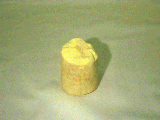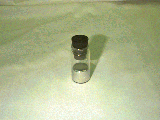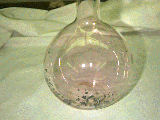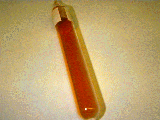 | The obvious physical properties are that sulfur is a yellow solid (rhombic sulfur). Less obvious but which we can locate in a reference book or textbook is that sulfur has a melting point of 112.8 C and boils at 444.6 C. Several allotropic forms exist. Orthorombic sulfur density is 2.069 g/cm3, monoclinic (at 95 C) has a density of 1.94 - 2.01 g/cm 3. |
 | Silvery, heavy, moveable liquid. Its melting point is -38 C, boiling point is 356 C. It has a very high density at 13.5 g/cm3. Mercury is readily enhaled. It is not so much of a hazard when ingested. Spilled mercury should be cleaned up immediately to prevent long term, low-level exposure. |
 | Iodine is black looking solid at room temperature and readily forms a violet vapor. The solid has a metallic luster and forms plates or scales. The vapor is corrosive with a sharp odor. Its melting point is 114 C, boiling point is 184 C and it has a density of 4.94 g/cm3. Iodine is not very soluble in hot or cold water, but it is soluble in solvents like alcohol, benzene and ether. Iodine is found in seawater. Ingestion of 2 to 4 grams have been known to be fatal. |
 | Nitrogen dioxide, NO2, is a brownish-red gas at room temperature. It is sealed in the glass tube to confine it and to protect us. Nitrogen dioxide is a poisonous gas. In the Merck Index Nitrogen dioxide is described as an 'insidious gas'. The gas can be fatal at a level of 200 ppm, and dangerous at 100 ppm. Its melting point is -9.3 C and it boils at 21 C. Its density is 3.3 grams/liter. |
Note: Sample chemical reactions were demonstrated and discussed in class.